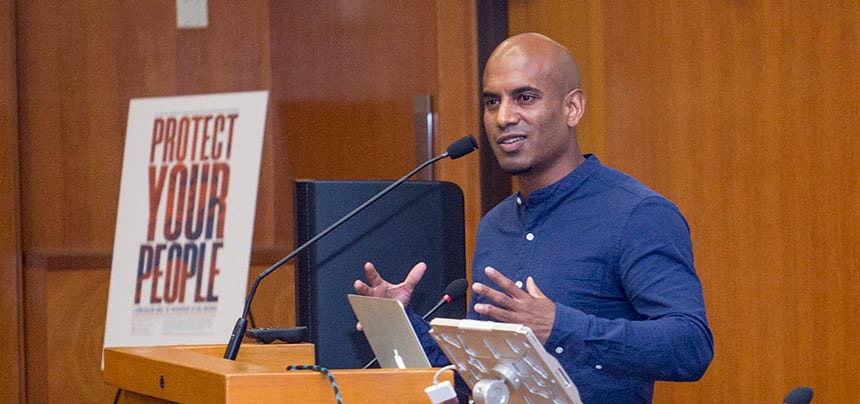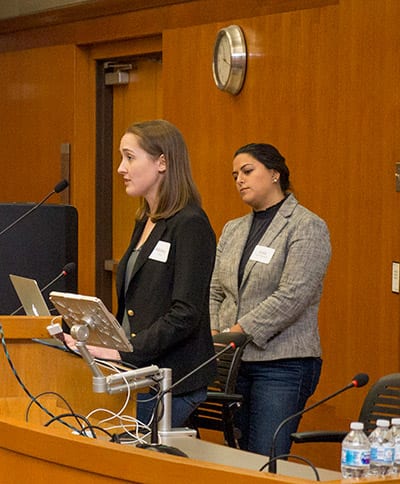
By Andrew Cohen
For Berkeley Law 3Ls Safa Ansari-Bayegan and Abbey Flynn, the participatory defense movement is a welcome model for people facing criminal charges, their communities, and the criminal justice system. The aspiring public defenders coordinated a recent symposium at the law school that explored the growing movement—and touted its benefits.
“Participatory defense elevates the precise voices that our system is designed to shut out,” Ansari-Bayegan says. “One of its many promises is that it supports families and those facing charges in efforts to claim a stake in our criminal legal process. The movement also highlights through its successes that community-led reform efforts are an integral piece to ending mass incarceration.”
Using innovative methods, participatory defense brings community organizing and advocacy into the criminal justice system in support of individuals facing civil or criminal charges. Family members and friends work with public defenders to create a full picture of their loved one, including positive traits, support of loved ones, and community ties.
The goal is to show a complete human being to judges, prosecutors, probation officers, and the public—rather than simply a list of charges—to reduce sentences and pre-trial detention.
The symposium convened local and national lawyers, law students, activists, and people affected first-hand by incarceration to explore how participatory defense works on the ground and how it can be further embraced by new communities—and lawyers—across the country. Attorneys noted the need to enlist the support of public defenders, who can be protective of their clients and are generally not used to collaborating with non-lawyers. See the opening keynote here.
Powers of persuasion

“You really need to teach attorneys about how participatory defense can lead to vastly different results for their clients,” says Flynn, who before law school researched public defense systems at the Urban Institute in Washington, D.C. “When attorneys hear the numbers, they get on board.”
The movement clearly resonates with many Berkeley Law students. A whopping 10 student organizations, journals, and legal services projects co-sponsored the event with the law school’s Thelton E. Henderson Center for Social Justice and Silicon Valley De-Bug—a San Jose-based community organizing and advocacy organization. De-Bug, which launched participatory defense 10 years ago, has reportedly saved 6,500 years of incarceration.
With now 36 hubs across the country, De-Bug leaders pointed to continued growth as vital in helping transform the landscape of power in court. Part of the National Participatory Defense Network, these hubs emphasize the far-reaching benefits of keeping families and communities together.
Symposium participants explained how participatory defense is a flexible format that “provides a framework organizers can use to address the specific harms happening in their community,” Flynn says.
One described how her hub in Nashville is pondering how participatory defense can best affect outcomes in school discipline or family defense proceedings. Another discussed how it is helping reduce bail and pretrial incarceration in Durham, North Carolina.
Local impact
Closer to home, De-Bug leader Raj Jayadev noted how organizers worked with the Alameda County Public Defender to stop the transfer of arraignments from Oakland to Dublin—enabling people to have their first court date at a courthouse accessible to friends and families.
“Participatory defense is defined by the organizers who are in courtrooms every day, meeting with family members of people going through the system, and fighting for structural change,” Flynn says.
De-Bug leaders Raj Jayadev, Sarait Escorza, and Cecilia Chavez spoke about their challenges and successes, and premiered two videos from De-Bug’s “Time Saved” series. Subsequent panels described how public defenders and organizers effectively collaborate and where the movement is likely heading.
Ansari-Bayegan and Flynn, co-presidents of Berkeley Law’s Criminal Defense Society last year, also made sure to provide a platform for people affected by incarceration who now work to prevent that harm from happening to others.
“Hearing from those affected first-hand by incarceration was key to really understanding the movement’s power and promise,” Ansari-Bayegan says. “Our hope is that learning about it encourages law students and practicing attorneys to consider how lawyers can accomplish more when they partner with and follow the leadership of community organizers.”
Watch
See De-Bug’s video about how the participatory defense movement turns time served into time saved.